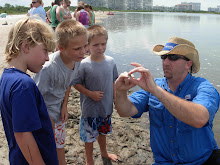Although much of the Gulf bottom is relatively featureless, “solution holes” exist that formed thousands of years ago when sea level was lower, and freshwater dissolved holes in the limestone surface. When sea level rose to its present state, these solution holes filled with sediment. Red grouper are commonly associated with these limestone solution holes, but scientists were never able to demonstrate they actually helped create and maintain them.
Coleman and her colleagues discovered that red grouper remove the sediment from these holes, and help restructure the flat bottom into a three dimensional structure. Much like beavers who construct dams, red grouper act as ecosystem engineers that modify their environment and create habitat for themselves and other species. They remove sand with their mouths, exposing the limestone bottom that can be colonized by other marine life such as corals, anemones, and sponges as well as the organisms that depend on them. The study also showed that commercially important species such as spiny lobster, black grouper, red porgy and vermillion snapper among others, benefited from the red grouper's engineering abilities. Red grouper, however, also benefited from digging the holes. “Watching these fish dig holes was amazing enough, Dr Coleman noted, “but then we realized that the sites served to attract mates, beneficial species such as cleaner shrimp that pick parasites and food scraps off the resident fish, and a variety of prey species for the red grouper. So it's no surprise that the fish are remarkably sedentary. Why move if everything you need comes to you?”
 Researchers observed excavating behaviors in both juvenile red grouper in shallow waters of the Florida Keys and in adults offshore in marine reserves in the Gulf of Mexico. Dr. Coleman noted, “We found through a series of experiments that they not only dug the holes, but maintained them by carrying mouthfuls of sediment from the center of the pit to the periphery and expelling them through their gills and mouths and then brushing off the rocks with their tail fins.”
Researchers observed excavating behaviors in both juvenile red grouper in shallow waters of the Florida Keys and in adults offshore in marine reserves in the Gulf of Mexico. Dr. Coleman noted, “We found through a series of experiments that they not only dug the holes, but maintained them by carrying mouthfuls of sediment from the center of the pit to the periphery and expelling them through their gills and mouths and then brushing off the rocks with their tail fins.”In the study juvenile groupers were placed in bottomless cages over sediment-filled holes, and were observed digging new holes; in one case a fish dug deep enough to escape the cage. Researchers also placed activated charcoal in multiple identified grouper holes in both shallow and deep waters to observe the rate at which red grouper excavated the material. They were observed removing the charcoal within two hours of being placed there, and most was completely removed from all sites within 24 hours. Researchers used video cameras to document the diversity and abundance of marine life associated with the groupers' engineering in the Keys. The research team discovered that the average numbers of fish were higher over grouper holes, and with bigger holes there were even larger numbers. For the offshore sites, researchers used submarines and remotely operated video camera to document species diversity and abundance. Active grouper sites had greater species diversity and abundance than inactive or sandy bottom sites. In one of the offshore study locations, most of the exposed rock was encrusted in sponges as well as soft and hard corals. Certain species such as sea urchins were only found at maintained grouper holes. Coleman’s study may have significant implications for future fisheries management and biodiversity protection, as it demonstrates critical connections between this economically valuable species and its environment. “What are the consequences of overfishing these habitat engineers?” asks coauthor Dr. Chris Koenig. “You can't remove an animal that can dig a hole five meters across and several meters deep to reveal the rocky substrate and expect there to be no effect on reef communities.”
The study entitled, “Benthic Habitat Modification through Excavation by Red Grouper, Epinephelus morio, in the Northeastern Gulf of Mexico,” is published in The Open Fish Science Journal.





This comment has been removed by the author.
ReplyDelete